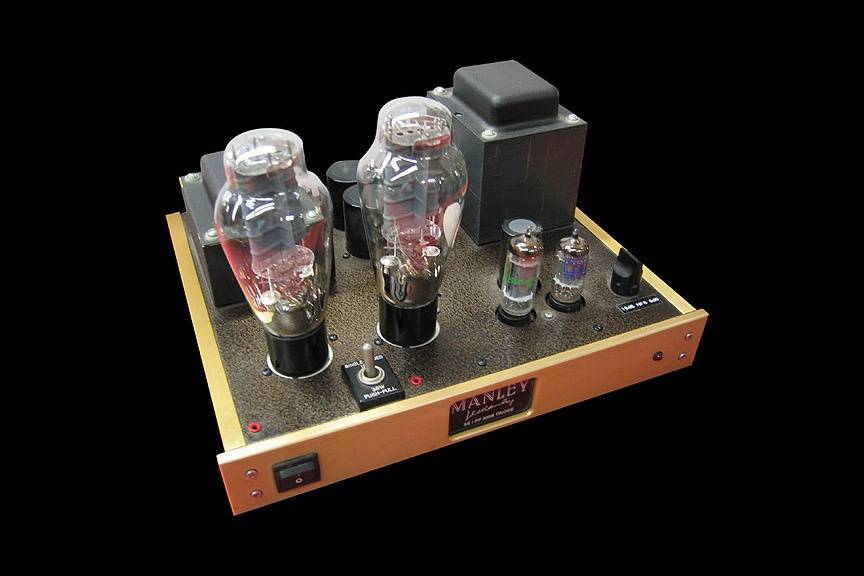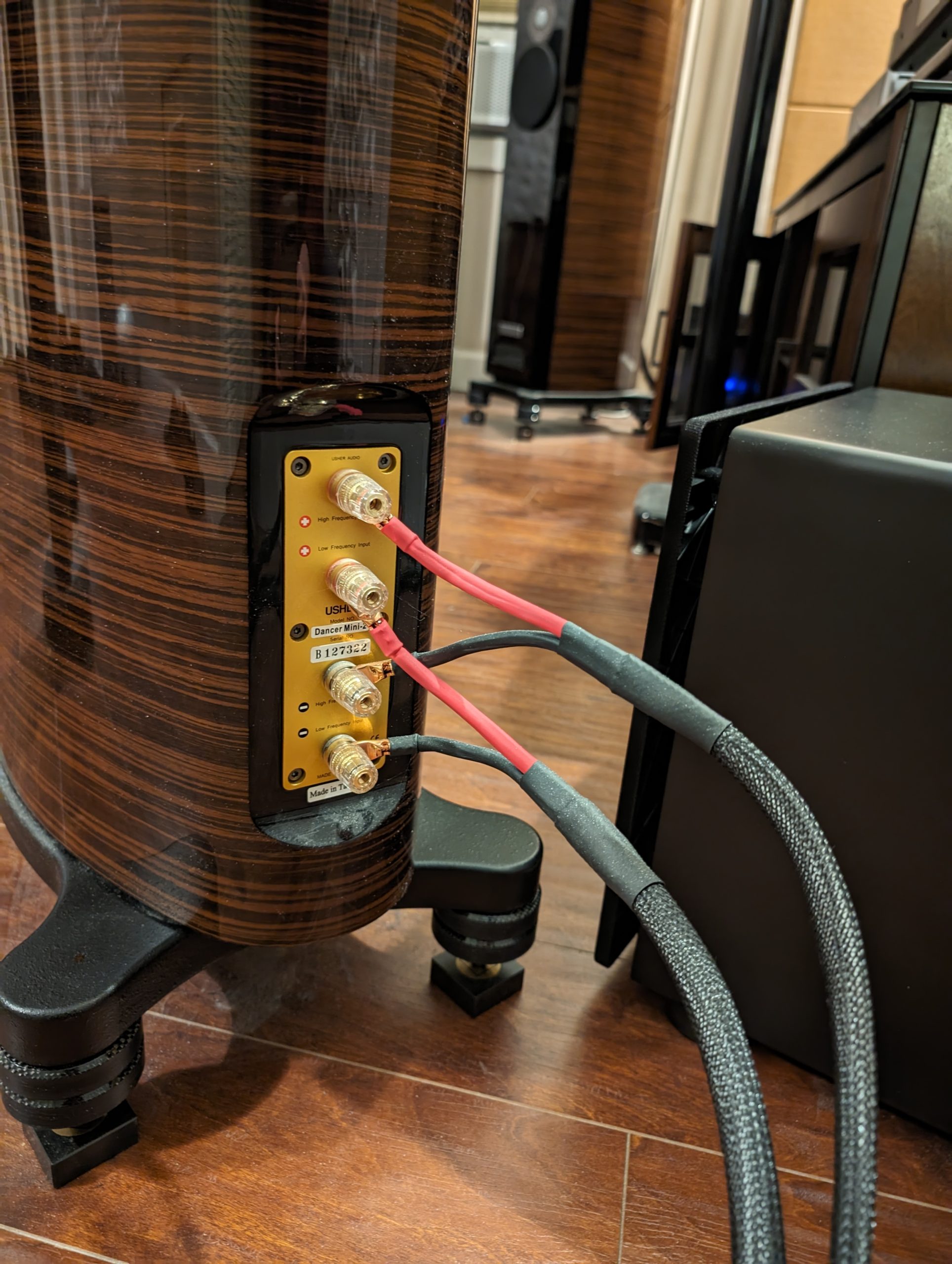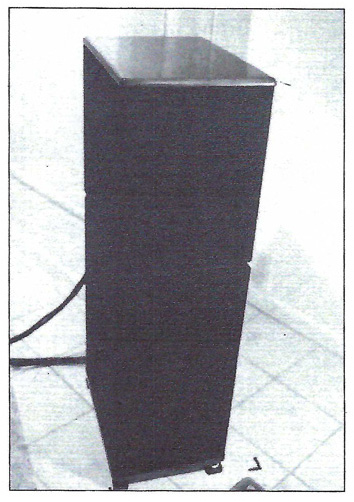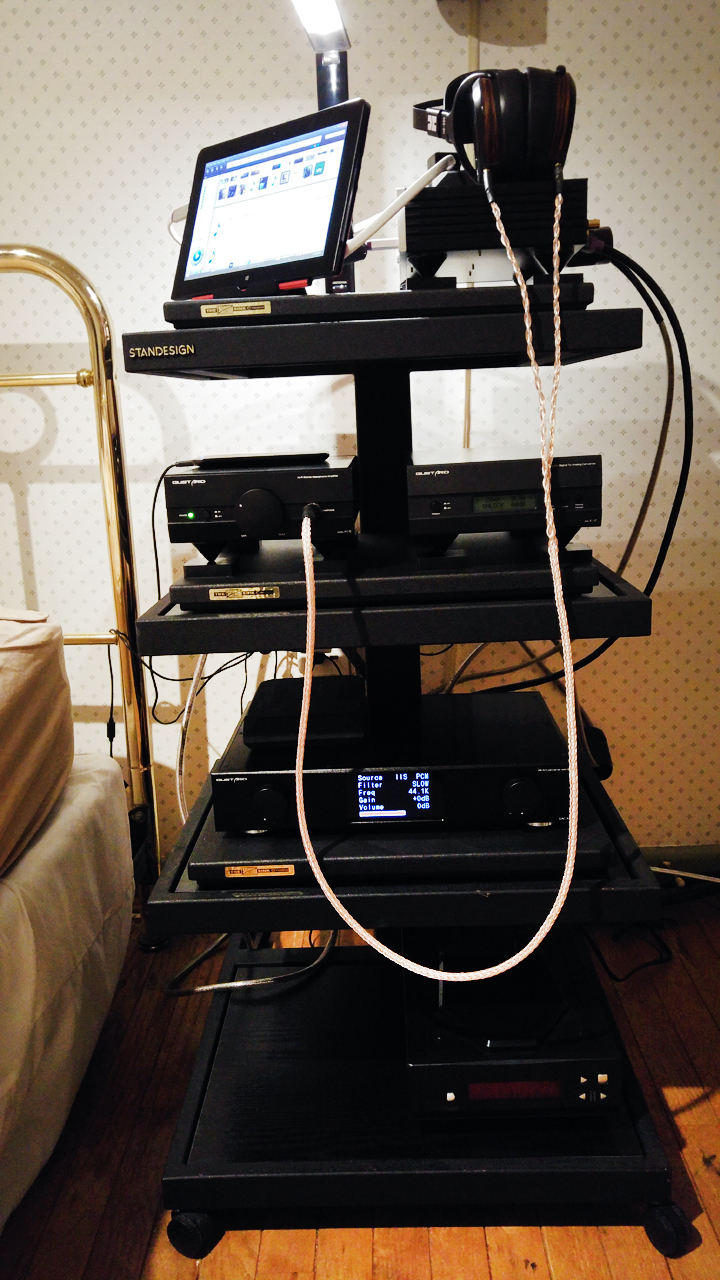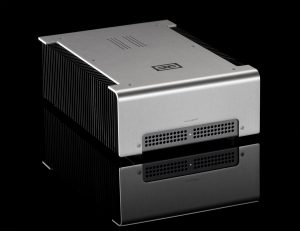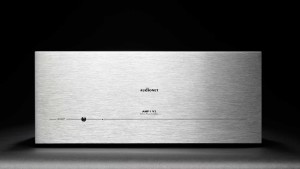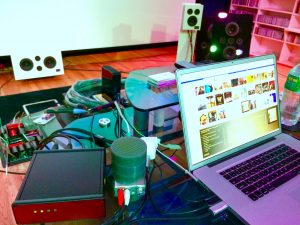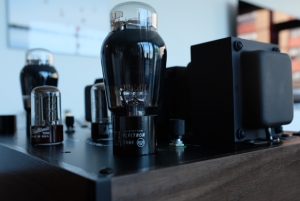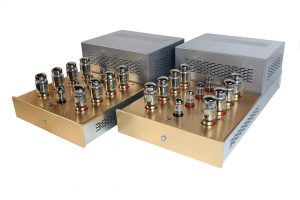This article originally ran in Volume 5, No. 2 of Positive Feedback
Back in the Tube Saddle Again
It's been a while, hasn't it? A couple of loudspeakers and a DAC got in the way, but now I'm back with a big embrace of those thermionic devices that I've grown to love. Since our last soirée in tubeville, I must confess that I have become even more of a tube supporter—that's like an athletic supporter, but with a heat shield to protect the family jewels. I'm right there on the sidelines cheering for the Tube team—watching with glee as the Lawrence Taylor of Tubes (that's SE 300B Triodes) sacks solid state, makes 'em cough up the ball, and runs it into the end zone to do a Bohemian victory dance. Did you see Bob Harley and John Atkinson square off in the Stereophile Cary 300Sei review?…Oh, man I'm loving this! I have a book review and interview with Bob coming in the next issue, and it is most enlightening…with frank talk on SE amps, the life of a technical editor, and who ends up wearing the punch bowl at Stereophile parties.
I've auditioned enough tube amps that I can now make some pretty safe general assumptions about how the amp will sound based upon the circuit design, PP or SE, the type of power tubes used, and the amount of feedback applied. So far, the choice is clear, at least for my loudspeakers and preferences—the answer is single-ended 300B amps with zero feedback. So how can I be so sure? How do I know the inherent differences between PP and SE and zero feedback vs. 1, 2, or 10 dB of feedback? Ahhhh….that brings us to our principal tube tale for this installment.
Manley makes me mental with a little help from Sam
"Hey Stu, you won't believe the amp I've got here...it's a real contender!" It was my tube pal Sam Tellig on the phone, bringing me up to date on his latest find. "It's a parallel single-ended 300B amp that David Manley sent me, and get THIS—you can switch it to push-pull on the fly, and you can dial in zero to ten dB of feedback... and hey, this thing sounds like real music!" It was pay back time. I'd been teasing Sam about the Golden Tube SE-40 and 300B monoblocks over the past few months, and now he was playing the trump card. He knew this would really get the juices flowing—"what's that you say?…18 watts parallel single-ended and 36 watts in push-pull!? No way Sam, that's outstanding!... but how much do they cost?" (Long Pause…drum roll please) "Well Stu, they're only $3500 bucks for the pair—Heh, heh, heh, heh..." (Sam's classic evil laugh). Now Sam and I have been listening to a lot of the same tube gear lately, including the Manley 35 watt monoblocks, I reviewed in a previous Tube Fest installment, and we have often reached the same conclusions. He knew exactly the effect our little chat would have. I hung up the phone with Sam and in a few fiber optic seconds I was on the horn with EveAnna Manley—"We've only got a prototype model available that was done in a brushed gold, with the feedback switch on the top of the chassis, but electrically and sonically its identical to the current production models…." "No problem EveAnna, I'll take it! Send it Pony Express, I'm dying over here." My favorite motor cycle lovin', colorful language equipped audio babe came through for me once again. The SE/PP 300B monoblocks in a one-of-a-kind gold finish arrived at my door in just a few days...and none too soon, with the likes of Sam Tellig stirring my pot!
Technical tid-bits
You've seen the picture of the SE/PP haven't you? Well, flip over to the full page ad in this issue and take a gander. It's one good looking little monoblock. An awful lot of performance has been squeezed into these 10x12x2 chassis that weighs in at modest 22 lbs. each. There's not a lot of wasted real-estate here—no big faceplate, air filled cabinet or great expanses of PCB with those looong traces…no siree, the signal path has been kept admirably short and the board layout is very tidy. Speaking of tidy—this is the only 300B monoblock I've had that will fit properly on a standard 16" deep equipment rack with a weight that works perfectly with the new Townshend CD sink (a product I heartily recommend for price and performance).
The output transformers are also very compact compared to what I've seen in other SE designs, but don't let the size fool you. Other SE amp manufacturers like to put full covers over the transformers that don't allow you to judge their true size. The Manleys are winding their M.A.G.I.C. transformers in house these days, and part of the "magic" may be their ability to get a huge amount of inductance into a compact package. To get a transformer to work effectively in both push-pull and single-ended operation does require some "magic." The SE mode places the greatest demands on the design, requiring an air gap to avoid the dreaded DC saturation and yet retaining enough Henries of inductance to get the job done. David Manley tells me that amongst other things, their custom wound transformers have far more inductance than conventional designs before the air gap is introduced. Another interesting feature of the transformer is that it is claimed to be wound as a true twin coil, with each half of the transformer having identical electrical properties. When in push-pull configuration the DC resistance, stray capacitance, and leakage inductance are said to be perfectly matched for each side—what David calls "precision push-pull."
The tube compliment is interesting too. The input stage uses a 12AT7 and a unique mil. Spec. GE 7044 twin triode. The 7044 is a very robust high current tube that is said to have outstanding matching of both triodes. The one draw back is the fact that it has a unique pin out configuration that makes tube substitution a no-no. This shouldn't make the tube rollers too upset, since all indications are that this one is superb, and the Manley's laid in a huge stash of these babies, so SE/PP owners are assured of replacements into the next decade.
The feature that truly sets this amp apart from every other amp on the planet is its ability to change on the fly from single-ended to push-pull operation with a mere flip of a toggle switch. Stop and think for a minute about the implications of this. Here you have an amplifier that will allow the truth seeking audiophile to experience the inherent sonic differences between these two hotly debated modes of operation. This is as close as it gets—same tubes, same parts, even basically the same transformer. From a reviewer's standpoint, this is an incredible opportunity, regardless of how good the amp sounds in either mode.
While you've got your lab coat on, you can also experiment with the effect that feedback has on sound. A chassis mounted rotary switch allows you dial in 0 to 10 dB of feedback in one dB increments. You can cook up just the right amount of feedback for your taste and you can tell which ingredient is more likely to spoil the brew—feedback, or mode of operation.
The Manleys are particularly proud of the test bench performance of the SE/PP in either mode, but in light of the, ahem…less than stellar bench performance of a certain SE integrated amplifier in a recently published review, I think it's the SE performance that really makes them proud.
The amp is reported to have a nearly picture perfect square wave, and has the ability to push nearly equal power into 4, 5, and 8 ohm loads. The full power bandwidth is rated at 18 watts at 1kHz with 1.5% THD into 5 ohms in SE mode, and 36 watts at 1kHz with 1.5%THD into 5 ohms in PP mode, 20 Hz-20kHz, with any feedback setting. This is spectacular performance, particularly for an SE amp. I didn't measure the amp myself, but given Mr. Manley's rather—shall we say "robust"—comments of late about SE amps, you can bet that he's not offering us his neck with these measurements. If anything, I'd wager that they are quite conservative. I'm told that David sent fellow Brit John Atkinson an SE/PP to measure. Knowing what an audio curmudgeon David is, he probably sent it along with a lovely note—"Hey mate, I know this SE stuff is a load of crap, but if you're going to test one, at least use one that isn't up to its nostrils in bilge water." I love this feisty guy! Tell you what, if I ever have an audio soirée at Stu's Place, David and EveAnna Manley are definitely going to be on the guest list. What a riot—can you imagine the Manleys together with Harvey "Gizmo" Rosenburg, Sam Tellig, David Robinson, Rich Brkich, and the rest of Stu's listening group? I see motorcycles (Benellis and Indians, of course!) pulling wheelies in the foyer, and I hear Harry Belafonté singing "Mamma Look a BooBoo" from Live at Carnegie Hall with a long Conga line of audio nuts wearing Harvey's "Tube Tribe" headdresses…makes me split a gut just thinking about it!
Another particularly impressive specification, for us passive preamp lovers, is the input sensitivity of the SE/PP 300B. In SE mode with zero feedback, a mere 450 mV will give you full output power. "So what is so special about that?"—you're thinking. Well, it's not terribly special, unless you happen to be using the extraordinary Muse II DAC that has only a 980 mV output and you also want to experience the transparency of the Reference Line Preeminence passive preamp. I happen to think this combination is fantastic and is capable of unleashing all of the SE/PP's potential.
Manley Makes Music...Man!
A little history is in order. I've had two other Manley amps in for review this year, and neither of them really lit my fire[1]. They had great macro-dynamics, but I felt they were lacking in other areas. I described them as painting a picture with primary colors and a broad brush. If, like me, you like the more subtle micro-dynamic stuff, the musical equivalent of pastel watercolors painted with a fine brush, you probably wouldn't make them your first choice. I thought their lower midrange was a bit thin (probably endemic to the pentode tubes) and that there was a slight leading edge emphasis in the treble transients. Typical of what I've heard from push-pull amps with a moderate amount of feedback, the soundstage on these amps was also a bit forward, very wide and somewhat compressed in depth.
Despite Sam's comments, my past experience helped me maintain a healthy skepticism about the SE/PP 300Bs. I was determined to put them through the deliberate paces, just like all the rest of the Tube Fest participants. After a decent burn in , I started with the amps in SE mode with zero feedback and settled into the sweet spot to soak in some of King & Moore's Impending Bloom….
"Zounds!"—I sat bolt upright in utter amazement at what I was hearing—I was just 30 seconds into the first track and I knew this was special. The tonal balance was right, no glare or edge, depth out the whazoo and ...what's this!?…startling dynamics from an eighteen watt SE amp!
In my sojourn into the land of single-ended triodes, I'd somewhat forgotten the skull crusher dynamics of the Macro-Manley sound. The SE/PP 300Bs retain a healthy dose of this in the SE mode and it is particularly noticeable in the bottom end. Perhaps it was because of the 18 watts produced by the parallel 300Bs as opposed to the 9 watts of the single tube amps I had been listening to lately (Cary 301 and Golden Tube 300B), or maybe it has something to do with the new transformer design—I really don't know—but these little monoblocks sounded like power houses.
It wasn't long before my curiosity got the better of me and I had to throw the toggle switches into PP mode. Instinctively, I turned my head away and winced as I threw the first switch. Hmm….no pop, no bang—tunes didn't skip a beat. I quickly hit the switch on the other monoblock and made a bee line for my sweet seat… .
I felt a strange sense of discovery come over me, sort of a cross between Doctors Pasteur and Frankenstein—"It's ALIVE, it's ALIVE! …mon Dieu, now vee are hearing zee TRUTH." For the first time I was hearing the inherent difference between single-ended and push-pull without the confusion of different wire, different parts, and different tubes...and what a difference! The soundstage expanded slightly in width, depth decreased, instrumentalists were moved forward on the stage, the midrange thickened, and the whole thing just seemed more like Hi-Fi than real music in real space. I'd heard this difference before when switching between single-ended triodes and other tube amps, but I was never quite sure if it was SE vs. PP or some other aspect of the design. Others might not find the difference as dramatic, but to me it was extraordinary. I went back and forth several times on different types of music, and yes, the difference was clear every time with the most dramatic distinctions occurring on minimalist recordings with lots of hall ambiance.
Brief intermission…
Before I blather on about the single-ended performance of these amps, I should make it clear that my personal preference for the SE mode should not be taken as a denigration of the push-pull performance of this amp. The fact is, with zero feedback, I think this may be the best push-pull sound of any of the Tube Fest participants to date. I just happen to crave that extra measure of magic that I hear in my system with the SE mode.
Now back to the show…
Other than a thickening of the midrange, there appears to be little difference in tonal balance or timbre of the instruments between the two modes. In my system , the SE mode had the clear edge in micro-dynamics, spatial effects, and a certain natural quality that I find difficult to articulate. The PP mode produces a somewhat wider, but much flatter soundstage, with the center vocalists or instrumentalists moved forward several feet. The PP mode also had a more ballsy sound, with slightly better transient response, greater low bass control, and what some might call better focus. On this latter point, I am not one of the "some." For me, this type of "focus" is really edge definition in a two-dimensional cardboard cutout sense. When you listen to live music, the instruments take up a more spherical space with no hard edges in sight, oops, I mean sound.
Where the SE mode truly shines is once again in the micro-dynamics—the fine pastel brush strokes, rather than the broad brush primary color stuff ...AND, most importantly, (and here's where the words fail me ) there is an uncanny sense of realness to the musicians floating between my speakers. It may be a combination of spatial characteristics, subtle timbre shifts, and pickled eye of Newt (the lizard, not the Speaker), but I definitely get more goose bumps when it's in SE mode. Mind you, for many listeners, these differences will not be of the "knock-you-out-of-your-chair" variety. Only people with very high resolution systems are going to truly appreciate these qualities. If the rest of your system does not do micro-dynamics, depth and image reproduction well, you might just say "yeah the PP mode has more dynamic impact and focus" and never realize what you have missed.
So what about feedback? Well, take what I have described as the drawbacks to the push-pull sound and multiply by a factor of two. There is no question in my mind that the effects of feedback are far more deleterious and that even in systems with mediocre resolution, the effects of feedback can be heard. As you dial in more feedback, the soundstage depth decreases, like the doors closing on Mystery Science Theater 2000, the micro-dynamics are progressively sucked dry and your midrange bloom becomes a blip. Feedback is an equal opportunity spoiler—the effect is more dramatic when operating in SE, but it will still ruin your day if you're in PP.
I shouldn't fail to mention the importance of proper tube biasing. I've found that there is a price to pay in SE designs when you increase power by paralleling tubes. Usually, that price comes in the form of slightly decreased focus and resolution. With careful biasing and tube matching, the focus gap between the single and multiple tube SE varieties can be closed to an inappreciable amount. The bias taps and adjustment pots are conveniently located on the chassis top plate of the SE/PP and I faithfully adjust them with a digital Volt-ohm meter before each listening session.[2] This can make the difference between "this is quite wonderful" and "Holy Cow!"
It should be obvious by now that I think that the SE mode with zero feedback is the way to go. In my listening room, with my system, and listening to the type of music that I enjoy (geesh, it's beginning to sound like a litany)—it's unmistakable. So, other than for scientific experiment purposes, why bother having PP and adjustable feedback? Because what's good for the goose may not always be good for the gander. I'm using the Von Schweikert Research VR4 loudspeakers and they just may be the perfect match for these amps. The nominal impedance is almost spot on the 5 ohms that the SE/PP is optimized for, and the impedance auto matching circuit keeps things pretty tame throughout the VR4's 20 Hz - 25kHz +/- 3dB frequency range. In another set up, the extra power afforded by the PP mode and dialing in greater edge definition and tighter low bass with a few db of feedback, may be just the ticket. OK, I confess that there are times when the spatial stuff and midrange purity just doesn't matter to me—like when I'm in the occasional crank up Joe Satriani's Surfing with the Alien kind-of-mood. Here's where even I can appreciate the tremendous flexibility this amp affords.
I think a few more words on amplifier flexibility is in order. I've found that the amplifier/ cable/speaker combination is so critical, that to fairly evaluate any one of these products you really need to look at all three. This is all the more true when sampling zero feedback single-ended triodes, given their low power and high output impedance constraints. There should be a red warning label placed on the top of all such reviews that says, "the conclusions reached in this review are limited solely to the equipment combination utilized. Your mileage may vary." My combination of Manley SE/PP, bi-wired Tice 416 cables and Von Schweikert VR4s is one that I could live with for a long time—in fact, I think I will. For those of you who do not have the good fortune of reviewing equipment and cherry picking the pieces that work best together, I think the SE/PP gives you a better chance than most tube amps, particularly SE, of getting a decent match. Because it delivers its power into a fairly broad range of impedances and changes its character significantly when you change operating modes and feedback, you have better odds of hitting the jackpot.
Ahhh… The sound of SE 300Bs. I can't let this review end without telling you about the many enchanted evenings I've spent listening to various versions of SE 300B amps. I've enjoyed the Anodyne MP300s, the Cary 301, and the Golden Tube Audio 300Bs over the past several months, and I hope to comment on them some more in future Tube Fest installments. Each one has a different flavor, but they all have that certain 300B tube magic. And what, pray tell, is this magic? Well, in the context of the SE/PP let me describe it this way: a truth of timbre and harmonic richness that glows with a reflection of the real thing and an enveloping sense of space that draws you deeply into the music. I sat transfixed hour after hour, night after night as Holly Cole enchanted me with the wonderfully quirky songs of Tom Waite on Temptation, and as I was ministered to by Mary Black on "The Holy Ground," The Anonymous Four on "The Lily & The Lamb," and Dawn Upshaw and Penolope Jenson on Vivaldi's "Gloria." Every great performance demanded another and for a longer stretch than I can remember, the laws of time and space were suspended.
Conclusions
The Manley 300 SE/PP is one outstanding amplifier and at its $3500 per pair price, it makes the Tube Fest "Stupid Good" list with room to spare. In my favorite SE zero feedback mode it sounds open and extended on top, and surprisingly tight and controlled way down deep. The tonality is very neutral, with no detectable heaviness in the mid-bass, nor any peaks or dips in the midrange presence region. Better still, it captures the whole harmonic envelope, every instrument sounding like the real thing no matter what the musical genre you feed it—light and sweet on chamber music, hauntingly atmospheric on Celtic tunes, and barking like a dog on rowdy jazz… and did I mention that you get "spooky real" imaging, and that it's transparent as all get out. All this and YES, dynamics, dynamics, dynamics!… Sounds like I should throw in a set of Ginzu knives, doesn't it.
It's pretty amazing when you think about it and perhaps a bit humorous as well. Here's a guy who doesn't think much of SE amps who's gone and made one that's killer and at super price to boot! I leave it up to the faithful legion of PF readers to find the poetic justice in this.
A Night Cap
It was very early one morning (about 1:30 am) when I decided to wrap up that night's program with "With God on Our Side"—a Dylan tune sung beautifully by Aaron Neville on the Neville Brothers, Yellow Moon. I was enveloped by the droning deep bass, bell peels, and that hypnotic tenor voice. I was starting to nod off, the eyes rolled back and eyelids closed and I was out... then, huh!?..I woke up with a start in my dark, warm and silent listening room with nothing but the blue glow of the four 300Bs and the illuminated signature face plates of the SE/PPs. I reflected for a few minutes on what an incredible achievement the SE/PPs are and gave them a well deserved salute good night.
[1] The Euro 35 monoblocks and the 175 watt monoblocks (strapped for triode operation).
[2] Checking the bias once a month should be sufficient after the tubes have broken in and stabilized.




